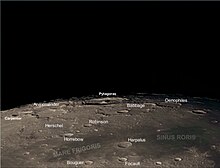

(four light spots are blemishes on original)
Pythagoras is a prominent impact crater located near the northwestern limb of the Moon. It lies just to the northwest of the somewhat larger Babbage. The crater has an oval appearance due to the oblique viewing angle. Only the western face of the interior can be viewed from the Earth, the other side being permanently out of sight.
The well-preserved rim of Pythagoras has a wide terrace system, and a slight rampart around the exterior. Although generally circular, the crater outline has a hexagonal form. The floor is flattened, but with an irregular, hilly surface. There is evidence of landslips around the periphery. In the center is a sharp, mountainous rise with a double peak that ascends 1.5 kilometers above the crater floor.
Pythagoras is a crater of Eratosthenian age.[1]
Satellite craters
By convention these features are identified on lunar maps by placing the letter on the side of the crater midpoint that is closest to Pythagoras.
| Pythagoras | Latitude | Longitude | Diameter |
|---|---|---|---|
| B | 66.1° N | 73.0° W | 17 km |
| D | 64.5° N | 72.0° W | 30 km |
| G | 67.8° N | 75.3° W | 16 km |
| H | 67.1° N | 73.3° W | 18 km |
| K | 67.3° N | 75.4° W | 12 km |
| L | 67.3° N | 77.6° W | 12 km |
| M | 67.5° N | 81.1° W | 10 km |
| N | 66.6° N | 78.1° W | 14 km |
| P | 65.3° N | 75.2° W | 10 km |
| S | 67.7° N | 64.7° W | 8 km |
| T | 62.5° N | 51.4° W | 6 km |
| W | 63.1° N | 48.9° W | 4 km |
References
- ^ The geologic history of the Moon. USGS Professional Paper 1348. By Don E. Wilhelms, John F. McCauley, and Newell J. Trask. U.S. Government Printing Office, Washington: 1987. Table 12.2.
- Wood, Chuck (October 9, 2007). "Copernicus on the Limb". Lunar Photo of the Day. Archived from the original on October 27, 2007. Retrieved 2007-10-09.
- Andersson, L. E.; Whitaker, E. A. (1982). NASA Catalogue of Lunar Nomenclature. NASA RP-1097.
- Blue, Jennifer (July 25, 2007). "Gazetteer of Planetary Nomenclature". USGS. Retrieved 2007-08-05.
- Bussey, B.; Spudis, P. (2004). The Clementine Atlas of the Moon. New York: Cambridge University Press. ISBN 978-0-521-81528-4.
- Cocks, Elijah E.; Cocks, Josiah C. (1995). Who's Who on the Moon: A Biographical Dictionary of Lunar Nomenclature. Tudor Publishers. ISBN 978-0-936389-27-1.
- McDowell, Jonathan (July 15, 2007). "Lunar Nomenclature". Jonathan's Space Report. Retrieved 2007-10-24.
- Menzel, D. H.; Minnaert, M.; Levin, B.; Dollfus, A.; Bell, B. (1971). "Report on Lunar Nomenclature by the Working Group of Commission 17 of the IAU". Space Science Reviews. 12 (2): 136–186. Bibcode:1971SSRv...12..136M. doi:10.1007/BF00171763. S2CID 122125855.
- Moore, Patrick (2001). On the Moon. Sterling Publishing Co. ISBN 978-0-304-35469-6.
- Price, Fred W. (1988). The Moon Observer's Handbook. Cambridge University Press. ISBN 978-0-521-33500-3.
- Rükl, Antonín (1990). Atlas of the Moon. Kalmbach Books. ISBN 978-0-913135-17-4.
- Webb, Rev. T. W. (1962). Celestial Objects for Common Telescopes (6th revised ed.). Dover. ISBN 978-0-486-20917-3.
- Whitaker, Ewen A. (1999). Mapping and Naming the Moon. Cambridge University Press. ISBN 978-0-521-62248-6.
- Wlasuk, Peter T. (2000). Observing the Moon. Springer. ISBN 978-1-85233-193-1.


Recent Comments